The Next Step: Digital Impressions
James C. Downs
How many times have you been in a situation where your preparation is done, it is time to take the impression, and you encounter this scenario? The tongue is fighting; the salivary glands are exploding; the gums are bleeding; the retraction cord is protruding; isolation is difficult; and the tray is under-filled, or, better yet, it is the wrong tray. Huge tori are present, you cannot get the tray to set fully, and just as the material starts to set, the patient goes into a convulsive gagging that is heard throughout the office.
After the struggle with a 4-minute impression, when the patient is reaching for the saliva ejector and complaining that the material tasted like burning tractor trailer tires, you notice, as clear as day, a bubble or void on the margin of the preparation. The imperfect reading of the crown margin means that you need to reimpress, or let the laboratory technicians figure it out by telling them to “make it work.” As your patient’s blood pressure returns to normal and that ashen gray dissipates from his or her face, you tell the patient that the impression was not good enough and there will be a need for a second one. That distraught look on your patient’s face says it all.
DIGITAL IMPRESSION TECHNOLOGY
Physicians have enjoyed outstanding 3-dimensional (3-D) graphics for collaborative medical applications for several years; however, the same cannot be said for dentists. When it comes to taking impressions for a traditional crown and bridge, digital technology has not been a viable option.
However, new technology has arrived to improve the impression-taking process for dentists and patients alike. As the icebox was replaced by the refrigerator, the advent of the high-speed handpiece and evolution of superior digital x-ray sensors means that the current impression-taking process, which dates back more than 200 years, will soon be a thing of the past. Touted as the next generation in impression taking, a new technical standard that will allow greater accuracy of fixed prosthetics is enthusiastically being embraced by dentists and dental laboratories.
There are several systems being developed, but one has come forward as the first to the dental marketplace. Cadent (Carlstadt, NJ) has developed iTero™, a digital impression system (Figure 1). By using a proprietary intraoral scanner, iTero can accurately capture the 3-D geometry of the tooth preparation area (Figure 2 and Figure 3 ). With each scan, iTero’s software captures 100,000 data points in a patient’s mouth. The digital models are magnified and displayed while the patient is still in the chair. This enhanced visualization, plus real-time analytical tools, allows the dental professional to make adjustments if necessary before completing the scanning process.
After the tooth is prepared, iTero will prompt the operator through a guided scan over the impression area with a hand-held optical scanning wand (Figure 4). Once the scans are complete, a voice prompt will inform the dentist and iTero will build a 3-D virtual model of the impression area (Figure 5). The resulting scan is free from bubbles, voids, pulls, and tears that are inherent in taking conventional impressions. A 3-D preview quality image is generated within 1 minute, enabling the operator to view the reduced area with opposing dentition articulated. This real-time visualization allows the dentist to confirm the required reduction and measure and verify proper occlusion and interproximal reduction.
Once the dentist approves the scan, the file is transmitted to a Cadent-partnering laboratory via a wireless Internet connection. The laboratory retrieves the digital file, makes any adjustments, and refines the virtual margin and coping. Next, the file is sent to Cadent, where a durable model is milled and sent back to the laboratory for creation of a highly precise restoration (Figure 6). All of this happens within standard service times.
UNRIVALED ACCURACY AND DURABILITY
The iTero digital impression system has been available to dentists commercially for more than a year. Prior to that, Cadent conducted a double-blind clinical evaluation of 200 crowns in a private dental practice setting. The evaluation was intended to see if the dentist saw a clinical difference in a digitally fabricated iTero crown vs. a crown fabricated from a traditional impression material, such as polyvinyl siloxane or polyether. During an 18-month period, the dentist took both a traditional impression and a Cadent iTero impression. After fabrication by the laboratory, two crowns, marked A and B, were sent back to the dentist. The dentist did not know which system had fabricated which crown. There were no models (working or solid) sent along with the crowns. The decision to seat either crown was entirely up to the dentist, who made his selection based on marginal fit, contacts, and proper occlusal height as well as proper shade and contours. After a crown was selected, the information pertaining to the crown was reported back to Cadent. In this double-blind clinical evaluation, Cadent reported that the participating dentist chose an iTero restoration over a conventional crown 70% of the time. Additional scanners were later made available to a larger beta testing group of 14 dentists for their evaluation in a second phase of beta testing in which more than 1,600 iTero crowns were seated.1
iTero models are made of an extremely chip- and abrade-proof material, unlike gypsum, which can shatter if dropped or mishandled in shipping. This author has placed over 140 restorations made from the iTero digital impression system with no remakes.
PATIENT COMFORT
Patient complaints about the traditional crown creation process can be distilled down to five common experiences:
- The tooth preparation, impression taking, and temporization process requires a long time in the chair.
- Tooth preparation is an unpleasant process.
- Impression materials taste bad.
- It is uncomfortable having the tray and impression material in the mouth.
- Patients dislike the drooling caused by the impression material.
The author has found in his own practice that patients prefer the iTero digital impression to the conventional impression method. He has also found that the iTero impression process is faster than taking a conventional impression, and that his patients find it more comfortable than having a tray in their mouth. Typically, up to 11 scans per arch are taken, which takes approximately 3 to 4 minutes to capture. The only complaint from patients is that they have to open their mouths for a prolonged period of time.
The art of impressioning has created numerous changes over the years. Three improvements that have been adopted by many dentists are the use of triple trays, faster curing materials, and automatic mixing systems. These new techniques have resulted in less preparation and clean-up time, fewer problems with the materials, and less human error. The author’s own laboratory, Arrowhead Dental Lab (Salt Lake City, UT), has told him that they believe approximately 60% of their single-crown impressions are taken with triple-tray technology, which allows the dentist to take impressions of the upper and lower teeth along with the bite registration at the same time. However, there are inherent problems with this technique, particularly with the bite registration. In the many seminars that the author has taught, dentists have reported that there were more retakes with the triple trays compared to traditional impression methods.
Impression materials have dramatically changed over the years. Two of the most recent improvements have been the creation of better-tasting impression materials and faster curing times. Patients seem to have no issues with better-tasting impression material compared to the old rubber-based impression material.
Automatic impression material mixers reduce mess and generate a uniform mix. The iTero digital impression system can scan from second bicuspid to second bicuspid and, according to the manufacturer, will have the capability to scan the full mouth in the near future. Because single-crown preparations are bread-and-butter dentistry for most dentists, this new feature will be important.
Also notable about iTero is the recording of the bite registration. The voice prompt instructs the user to scan a virtual real-time closed bite of the prepared tooth and adjacent tooth in the quadrant. The models produced are set up for a standardized articulator, which eliminates plaster mounting or guessing with the bite registration material.
LESS SEATING TIME
According to Arrowhead Dental Lab, dentists are telling their doctor relations representatives that using digital impressions has significantly reduced the time it takes to seat a crown. In the author’s opinion, this decrease in chairtime is a direct result of the iTero model’s accuracy. It now takes the author more time to anesthetize the patient and remove the temporary crown than it does to cement and seat the crown. The author rarely needs to spend more than a minute adjusting contacts or occlusion, and the marginal fit is superb. The model material is indestructible and is similar to the silver-plated die technique used years ago.
Digital impressions eliminate numerous areas of potential error, either by humans or with materials and techniques. The dentist has incredible follow-through, the laboratory gets an extremely accurate impression/model, and, most importantly, the patient gets an exceptional crown.
WITNESS THE DIGITAL REVOLUTION
Digital impression systems are already generating a buzz in the dental industry. The conventional impression process will be replaced, similar to how digital x-rays have replaced film. The impression-taking process sets the tone for the final outcome of a laboratory-produced restoration. Digitally scanned impressions communicated through the Internet to CAD/CAM milling centers will expedite the fabrication of restorations.
This digital communication will save time by automating the process and eliminating the need for adjustments. Personally, the author prefers the excitement of placing a crown that is correct in every aspect. The dentist and technician who use this advanced technology will find ways to shorten turnaround times, increase accuracy, reduce chairside time, and create value for the patient.
REFERENCES
1. Data on file. Cadent. Carldstadt, NJ.
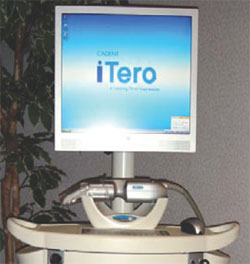 | 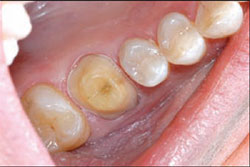 |
| Figure 1 The iTero digital impression system. | Figure 2 View of the prepared area to be scanned. |
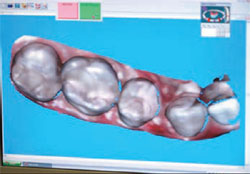 | 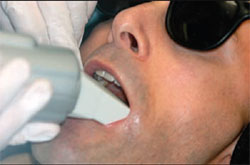 |
| Figure 3 iTero can accurately capture the 3-D geometry of the tooth preparation area. | Figure 4 iTero will prompt the operator through a guided scan over the impression area with a hand-held optical scanning wand. |
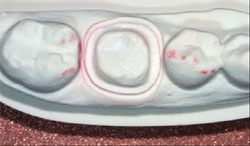 | 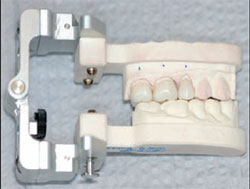 |
| Figure 5 Once the scans are complete iTero will build a 3-D virtual model of the impression area. | Figure 6 The approved scan file is sent to Cadent, where a durable model is milled and sent back to the laboratory for creation of a highly precise restoration. |
| About the Author | |
| James C. Downs, DMD Private Practice Denver, Colorado Instructor, The Dr. Dick Barnes Group |



